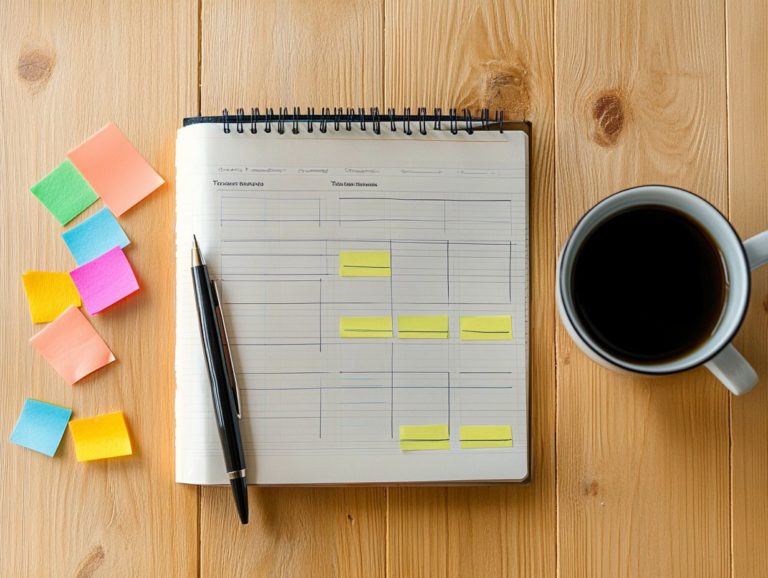10 Unique Strategies to Boost Your Efficiency
In today s fast-paced world, enhancing your productivity has become an essential pursuit. Whether you re juggling work commitments, personal projects, or daily tasks, effective strategies can significantly maximize your time and energy.
Get ready to discover game-changing tips! This article lays out ten unique approaches to boost your efficiency, ranging from crafting a daily schedule to leveraging advanced time-management tools. You ll learn how to prioritize your tasks, eliminate distractions, and maintain a laser focus all designed to transform the way you work and live.
Contents
- Key Takeaways:
- 1. Create a Daily Schedule and Stick to It
- 2. Prioritize Your Tasks
- 3. Take Breaks and Rest Properly
- 4. Eliminate Distractions
- 5. Delegate Tasks When Possible
- 6. Use Time-Management Tools
- 7. Set Realistic Goals
- 8. Stay Organized
- 9. Automate Repetitive Tasks
- 10. Use the Pomodoro Technique
- How Can You Identify Your Most Productive Time of Day?
- Frequently Asked Questions
- What are the 10 unique strategies to boost my efficiency?
- Why is prioritizing tasks important for boosting efficiency?
- How can creating a schedule help with efficiency?
- How can delegating tasks supercharge your productivity?
- How can taking breaks improve efficiency?
- What are some ways to eliminate distractions?
- How does using technology contribute to efficiency?
- Why is mindfulness important for efficiency?
- What role do goals play in boosting efficiency?
- How can automating tasks save time and increase efficiency?
- Why is continuous learning important for boosting efficiency?
Key Takeaways:

- Create a daily schedule and stick to it to boost your productivity.
- Prioritize tasks to focus on the most important ones first.
- Take regular breaks to prevent burnout and keep your energy high.
1. Create a Daily Schedule and Stick to It
Creating a daily schedule is essential for enhancing efficiency in your business operations. It helps maximize productivity through structured time management and strategic task batching.
This organized approach not only helps you prioritize tasks effectively but also reduces distractions and keeps you focused throughout the workday. Tools like Google Calendar streamline scheduling by setting reminders for important deadlines and meetings, ensuring that nothing slips through the cracks.
Project management applications such as Trello allow you to visualize your workload, making collaboration smoother and boosting accountability within your team. Regular check-ins foster employee engagement, motivating individuals to stick to their schedules and fostering a sense of ownership over their tasks. This ultimately drives both performance and satisfaction in the workplace.
2. Prioritize Your Tasks
Effectively prioritizing tasks is crucial for enhancing your overall efficiency, allowing you to concentrate on high-impact activities while harnessing the power of the Pareto Principle for optimal results.
The 80/20 rule illustrates how a small subset of tasks can yield the majority of your outcomes. Thus, it’s vital to pinpoint and focus on those high-value activities.
Tools like Asana and Trello streamline this process, enabling you to visualize your workload, categorize tasks, and set deadlines. This ensures you manage your time with precision.
By leveraging these tools, you can quickly discern which projects demand your immediate attention and which can be scheduled for later, fostering a balanced approach to productivity that aligns seamlessly with your strategic goals.
3. Take Breaks and Rest Properly
Regular breaks and adequate rest are essential for helping you grow and enhancing overall efficiency. These practices help maintain your productivity levels and prevent burnout.
Engaging in mindfulness activities during breaks, like meditation or a quick walk, not only rejuvenates your mind but also boosts your focus and creativity. Research shows that even a five-minute break can lead to a remarkable 30% increase in productivity, enabling you to tackle your tasks with renewed energy and clarity.
Studies have found that organizations encouraging regular breaks report lower stress levels among employees, resulting in a happier and more engaged workforce. By embracing these practices, you enhance your well-being and contribute to a more vibrant workplace environment.
4. Eliminate Distractions
Eliminating distractions in your workplace is crucial for maintaining peak efficiency. Focus on your tasks to make the most of technology tools that enhance your time management.
Common interruptions, such as excessive email notifications, casual chatter from coworkers, and the pull of social media, can easily derail your productivity. To tackle these distractions, implement communication tools like Slack or Zoom. These platforms provide structured messaging channels that reduce impromptu conversations, helping you maintain concentration.
You can use chatbots to automate repetitive inquiries and tasks, streamlining workflows and freeing up valuable time for more critical projects. By creating a distraction-free environment, you can use these tools to stay organized and engaged, leading to more effective outcomes.
5. Delegate Tasks When Possible
Effective delegation can significantly enhance your business operations. It improves employee engagement and allows you, as a leader, to focus on managing projects and strategic initiatives.
This practice recognizes your team members’ strengths and fosters a sense of ownership and accountability. For instance, when a project manager assigns a team member to oversee the design aspect of a project, it allows them to concentrate on the broader strategy and client communications.
Consider outsourcing non-core tasks, such as accounting or IT support, to streamline operations further. This approach allows you to allocate resources more strategically, driving collaboration and enhancing productivity across your organization.
6. Use Time-Management Tools
Utilizing time-management tools is essential for improving your business operations. They help with time tracking and ensure effective workflow optimization.
Platforms like Trello and Asana offer intuitive interfaces that let you visualize projects and assign tasks easily. These innovative solutions can transform how your team collaborates and manages tasks.
Automation tools like IFTTT and Zapier streamline repetitive processes, reducing errors and saving you valuable time. Embracing these tools cultivates a cohesive environment where team members are aligned and focused, resulting in smoother operations and increased productivity.
7. Set Realistic Goals

Setting realistic goals is vital for boosting efficiency and productivity in your business. Aligning employee development with achievable outcomes enhances customer relationship management.
Using the SMART criteria Specific, Measurable, Achievable, Relevant, and Time-bound guides your teams toward clear objectives that improve performance. This process helps employees understand expectations, fostering a culture of accountability and motivation.
Realistic goal-setting enhances employee engagement by ensuring individuals feel their contributions are meaningful and attainable. This sense of ownership not only boosts personal satisfaction but also influences overall business success.
Motivated employees are more likely to exceed targets and deliver exceptional results, benefiting the entire organization.
8. Stay Organized
Staying organized is crucial for boosting efficiency in your business operations. It enables your team to manage projects, track inventory, and ensure that essential tasks are completed right on schedule.
In today s fast-paced work environment, embracing technology can elevate your organizational capabilities significantly. Tools like Google Workspace enable you to collaborate seamlessly.
This allows your team to share documents, schedule meetings, and communicate effectively, no matter where they are.
Project management software, such as Trello or Asana, provides a structured approach to outlining tasks, assigning responsibilities, and monitoring progress all vital for keeping your projects on track.
To further enhance your organization, adopt best practices like maintaining tidy physical workspaces and implementing digital filing systems. Regularly decluttering both your physical and digital environments makes it easier to find important documents and helps you focus on your responsibilities without the distractions that come from chaos.
Start organizing today, and watch your efficiency soar!
9. Automate Repetitive Tasks
Automating repetitive tasks is a powerful strategy for enhancing your efficiency, allowing you to focus on more complex and creative work while technology tools, like artificial intelligence and chatbots, handle the mundane.
This shift not only lifts the weight of routine duties off your shoulders but also opens doors to new ideas and solutions for your team.
You can streamline everyday activities using tools like workflow automation software, project management applications, and customer relationship management (CRM) systems to make tasks like data entry, scheduling meetings, and tracking project deadlines more efficient.
For instance, by using software like Zapier to integrate various applications, you can automatically update spreadsheets with new customer data or send reminders for upcoming deadlines, minimizing human error and saving you valuable time.
The end result? A significant boost in your productivity, enabling you to dedicate more energy to strategic initiatives that propel your business toward success.
10. Use the Pomodoro Technique
The Pomodoro Technique is a powerful time management method that can elevate your efficiency by breaking your work into focused intervals while incorporating simple relaxation techniques to boost productivity.
By segmenting your tasks into manageable 25-minute chunks, you can immerse yourself fully in your work without feeling overwhelmed. This structured approach encourages you to take regular breaks. These pauses refresh your mind and help prevent burnout.
The rhythm of intense work followed by short pauses not only sharpens your concentration but also helps you maintain motivation throughout the day.
To implement this technique effectively, start by selecting a specific task, setting a timer for your 25-minute interval, and minimizing distractions during that period. After completing your Pomodoro, indulge in a brief five-minute break, and watch your overall energy levels soar.
How Can You Identify Your Most Productive Time of Day?
Identifying your most productive time of day is crucial for enhancing efficiency. It enables you to develop optimized time management strategies that align seamlessly with your unique productivity patterns and foster your growth.
By leveraging data analytics to track your work habits, you can uncover valuable insights into when your focus and creativity hit their peak. Engaging in self-assessment through journaling or using productivity apps can clarify when distractions tend to creep in and which tasks ignite your motivation.
With this knowledge at your fingertips, crafting a schedule that prioritizes high-impact tasks during these optimal windows becomes effortless. This approach not only maximizes your output but also ensures that you tackle the most challenging work when your energy levels are at their best.
Incorporating short breaks and lighter activities during your less productive periods can further enhance your overall workflow, helping you maintain sustained momentum throughout the day.
What Are Some Habits That Can Boost Efficiency?
Incorporating specific habits into your daily routine can significantly elevate your efficiency. Enhance your productivity through effective time management and mindfulness activities tailored to your individual needs.
One transformative practice you can adopt is task batching. This technique involves grouping similar tasks together, reducing the mental fatigue of constantly switching between different types of work.
By doing so, you create a focused flow of energy. This allows you to dedicate uninterrupted blocks of time to specific activities.
Implementing time tracking can provide invaluable insights into how you spend each hour. This enables you to make proactive adjustments for better use of your time.
To seamlessly integrate these methods, designate specific time slots for similar tasks each day. Consider using apps or planners to monitor your time expenditures throughout the week.
These time management tools help identify patterns and pinpoint areas for improvement, ultimately leading to a more streamlined and efficient daily routine.
How Can You Overcome Procrastination?
Overcoming procrastination is crucial for achieving peak efficiency. Don t let procrastination hold you back from your goals! Take action today!
Implement small, manageable goals to break down larger tasks into achievable steps. This makes them feel far less daunting.
Leveraging accountability measures, like partnering with a colleague or using productivity apps, can keep you motivated and on track.
Tools such as the Pomodoro Technique a method where you work for 25 minutes and then take a 5-minute break or to-do lists offer structured methods for allocating your time effectively.
These strategies not only cultivate a sense of accomplishment as you complete tasks but also encourage a positive feedback loop. This reinforces the habit of timely execution and ultimately leads you to greater success.
What Are Some Common Time-Wasting Activities?

Identifying common time-wasting activities is essential for enhancing your efficiency. This enables you to tackle distractions that undermine your time management and impact your overall productivity.
In today s fast-paced work environment, you might find that excessive meetings, lengthy email threads, and aimless web browsing are among the culprits. These distractions can derail your focus, leading to diminished morale and engagement within your team.
To counteract this, implement structured agendas for meetings. Encourage concise communication and utilize productivity tools designed to minimize distractions.
By nurturing a work culture that values time and emphasizes meaningful engagement, you ll feel more invested in your tasks and improve your overall output and job satisfaction.
How Can You Stay Focused and Motivated?
Staying focused and motivated is essential for maintaining your efficiency. It fosters consistent productivity and supports your development through effective mindfulness practices and leadership training.
When you set clear, achievable goals, you create a roadmap that guides your efforts and reinforces your commitment. This clarity sharpens your concentration and instills a profound sense of purpose, propelling you to excel.
Incorporating mindfulness techniques, such as meditation or focused breathing, can enhance your attention and reduce stress. This enables you to perform better in high-pressure situations.
Leadership training is also important. Leaders with strong interpersonal skills can inspire their teams by recognizing achievements and instilling confidence. This creates an environment where everyone feels enabled to thrive.
What Are Some Strategies for Managing a Heavy Workload?
Effectively managing a heavy workload is crucial for maintaining your efficiency. It requires strategic time management that emphasizes your development and may involve outsourcing non-core tasks.
To navigate this challenge, consider adopting several strategies. Start by prioritizing tasks based on urgency and importance; this approach helps you focus your efforts where they’re needed most.
Delegation is a critical strategy. By trusting your team members with responsibilities, you alleviate pressure and foster growth within the team.
Utilizing project management tools, such as Gantt charts or task management software, can streamline your workflows, facilitate communication, and enhance accountability. Feeling overwhelmed? Outsourcing tasks can be a game-changer! This can significantly boost productivity and allow you to concentrate more on your core responsibilities.
Frequently Asked Questions
What are the 10 unique strategies to boost my efficiency?
- Prioritizing tasks
- Creating a schedule
- Delegating tasks
- Taking breaks
- Eliminating distractions
- Using technology
- Practicing mindfulness
- Setting goals
- Automating tasks
- Continuous learning
Why is prioritizing tasks important for boosting efficiency?
By prioritizing tasks, you can focus on the most important and urgent tasks first, making the most of your time and energy. This also helps prevent you from feeling overwhelmed and allows you to accomplish more in less time.
How can creating a schedule help with efficiency?
A well-organized schedule can help you stay on track and efficiently manage your time. It allows you to allocate specific time slots for tasks, avoid overcommitting, and ensures that important tasks are not forgotten or neglected.
How can delegating tasks supercharge your productivity?

Delegating tasks can free up your time to focus on more important tasks and allow others to use their skills and expertise. This can result in better efficiency as more tasks can be completed simultaneously.
How can taking breaks improve efficiency?
Taking breaks can help you recharge and refocus, ultimately increasing your productivity and efficiency. It also helps prevent burnout and allows you to come back to tasks with a fresh perspective.
What are some ways to eliminate distractions?
Some strategies for eliminating distractions include turning off notifications, finding a quiet workspace, and setting boundaries with colleagues or family members. You can also use productivity tools to block specific websites or apps during designated work times.
How does using technology contribute to efficiency?
Technology can automate certain tasks, provide organization and communication tools, and offer information and resources for learning and problem-solving. Using the right technology can significantly boost efficiency in various areas of your work and personal life.
Why is mindfulness important for efficiency?
Mindfulness helps you stay present and focused on the task at hand, reducing distractions and increasing efficiency. It also helps manage stress and improve decision-making skills, leading to better productivity and efficiency.
What role do goals play in boosting efficiency?
Setting clear and specific goals can help you prioritize tasks and focus on what is most important. It also provides a sense of direction and motivation, leading to increased efficiency and accomplishment.
How can automating tasks save time and increase efficiency?
By automating repetitive tasks, you can save time and energy, allowing you to focus on more critical tasks. This can also reduce the risk of human error and ensure consistency and efficiency in completing these tasks.
Why is continuous learning important for boosting efficiency?
Continuous learning allows you to acquire new skills and knowledge to improve your work processes and strategies, leading to increased efficiency. It also helps you stay updated and adapt to changes in your field or industry.






